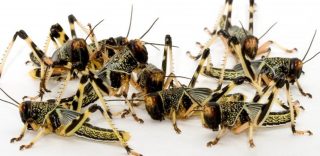Kenyan scientists have urged the government to seek help for the use of advanced drone technology to contain the migratory desert locust ravaging the country’s farms and grazing fields. This call is coming as a result of the inefficiency of Kenya’s strategy to curb the menace.
In a statement to Daily Nation, the chairman of the Entomological Society of Kenya, Dr Muo Kasina stated that “the government needs to get help from countries with advanced drone technology like the United States, Israel, and Denmark to deal with the locust menace before it gets out of hand.”
Currently, Kenya’s Agriculture Ministry makes use of aircraft to do aerial spraying of pesticides on farms and grazing fields. However, the overwhelming swarm of locusts has proven to be winning the war.
Kasina further recommended the adoption of drones due to the limitations in the use of aircraft that has seen the locust increase in numbers. He went on to explain that deep valleys and mountain contours, where the raving locust may be passing may not be easily accessed by aircraft as much as drones would.
The UN’s growing concern.
The United Nations (UN) recently solicited for more aid from the wider international community, an indication of growing concern, with a view to curbing the looming threat of food insecurity in the East Africa region. Even though the UN released $10 million from its Central Emergency Response Fund to counter the outbreak, it still seeks urgent support from the international community to help tackle the situation.
The outbreak is the worst that countries in the region have encountered in decades. The swarms have affected parts of Ethiopia, Eritrea, Djibouti, Somalia, Sudan, and Kenya. Other countries in the region – Uganda and South Sudan- have received a warning alert from the Intergovernmental Authority on Development (IGAD) that they could be next.
In November 2019, the UN urged Ethiopia to curb the locust infestation that ravaged 4 of its states before it would spread to other neighbouring nations. But a devastating mass protest which claimed the lives of many in the Horn of Africa country slowed the activities of pest control workers. The torrential rain that lasted till January 2020 further aided the breeding of the pest.
The current invasion of desert locusts in Ethiopia and in most of the other East African nations has become a huge threat to food security in the region. If the governments of this region would respond to this call by scientists and consider the use of advanced drone technologies, much progress could be recorded.
What you should know about Desert Locusts
The desert locust is a species of short-horned grasshoppers (Acridoidea) that are known to change their behaviour and form swarms of adults or bands of hoppers.
An adult desert locust can consume roughly its own weight in fresh food, which is about 2 grams per day, while small swarm can consume the equivalent of food for 35,000 people in one day.
A single locust can travel 150 kilometres and during plagues, a swarm can spread over an area as large as 29 million square kilometres. That is, it can extend over or into parts of 60 countries during a plague period. This is about 20 percent of the total land surface of the world.
There can be at least 40 million and sometimes as many as 80 million locust adults in each square kilometre of a swarm and they have the capacity to damage the livelihood of a tenth of the world’s population.
It is important to note that locusts do not attack people or animals and there is no evidence that suggests that they carry diseases that could harm humans. However, if the governments of the East African region do not intensify its effort to contain these raving pests, the region may then have to battle hard to save its people from starvation.








